


 Usually, products that teach tactics, whether books or programs, tend to be divided into three categories: basic, intermediate or advanced. With few exceptions, they will all delve into a brief exposure of each established concept, and then provide a more or less large list of exercises to solve. The obvious and established theory is that it is all about pattern recognition and doing the legwork. There is nothing wrong with this, but for many it is still an arduous task reaching that next level, and the practical games never seem to develop those attractive ideas shown in the book.
Usually, products that teach tactics, whether books or programs, tend to be divided into three categories: basic, intermediate or advanced. With few exceptions, they will all delve into a brief exposure of each established concept, and then provide a more or less large list of exercises to solve. The obvious and established theory is that it is all about pattern recognition and doing the legwork. There is nothing wrong with this, but for many it is still an arduous task reaching that next level, and the practical games never seem to develop those attractive ideas shown in the book.
GM Rustam Kasimdzhanov’s DVD, The Power of Tactics, takes a slightly different approach, in many ways filling in a lesser explored area in the teaching of tactics. In the introduction, he explains that after carefully studying the games that were resolved by tactical devices, he noted that three themes clearly dominated more than others: the pin, the double attack, and the back rank weakness. When noting the DVD actually has over four hours of lectures, I will be honest in saying I was extremely dubious about what he could possibly say on these three themes alone, and the first lecture after the introduction almost seemed to vindicate this fear, and I thought, “Oh boy...” Rustam was clearly conscious of this, and even requested patience if this initial exposure was basic to the point of boring for the viewer, that it would not be so and there would be valuable considerations as it went along. Were there? Actually, yes, and refreshingly so.

Rustam Kasimdzhanov explains the mechanics behind a basic double attack
The first theme covered is the pin, and let’s face it: the basic concept is not rocket science. However, who has not had a game where a pin seemed to dictate the course of the game? Not merely some “oops, I lost a rook”, but rather one that entailed all manner of pressure as well as threats all around that broke the back of the player on the receiving end. Naturally, these are not pure pins, as they are upheld and threaten with the use of other tactical devices, however, the pin is the fundamental theme. As a result, Kasim explores the numerous methods a player has to get out of a pin, whether directly or indirectly via alternate threats of his own. Is that all? Hardly. Pins are not merely elements to be exploited when they appear on the board, they can be set up to be exploited, much as any positional part of a game, and we are shown the thinking that can lead to developing this sort of sneakiness into our game, and what to watch for to avoid falling for it. The examples grow from elementary club play, to spectacular and beautiful examples from past and modern grandmaster play, always accompanied by explanations on the thinking that can lead one to see the ideas or develop them.

Just one of the many spectacular combinations dug up, shared, and dissected
The lectures on the double attack pursue this line of thinking, showing that a double attack is not merely one of two pieces being attacked, or a pawn fork, but any two simultaneous threats that cannot both be prevented. He explains that ultimately the double attack is based on one of the most fundamental concepts in chess, the theory of two weaknesses, that affects even basic endgames. Naturally, he endeavors to show the interconnectedness of the themes, which becomes far more evident once the absolute basics are past.
At the end there are exactly zero exercises to solve, as this is not the purpose here. Kasimdzhanov strives to help teach players how to think and approach these themes and even how to build upon the basics into more and more complicated examples, so that the inclusion of tactics in one’s game goes beyond the mere pouncing on the opponent who slipped on a banana peel. He wants to teach you how to deliberately set up that banana peel yourself and ambush the unsuspecting victim. Even if you have studied tactics and solved X number of exercises, sometimes it isn’t so much what is being taught as how, and this might be your key to the next level.
The Power of Tactics can be found at the Chessbase Shop here.